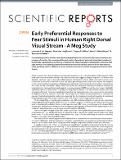| dc.contributor.author | Meeren, Hanneke K. M. | |
| dc.contributor.author | Hadjikhani, Nouchine | |
| dc.contributor.author | Ahlfors, Seppo P. | |
| dc.contributor.author | Hamalainen, Matti S. | |
| dc.contributor.author | de Gelder, Beatrice | |
| dc.date.accessioned | 2016-07-20T16:05:11Z | |
| dc.date.available | 2016-07-20T16:05:11Z | |
| dc.date.issued | 2016-04 | |
| dc.date.submitted | 2015-10 | |
| dc.identifier.issn | 2045-2322 | |
| dc.identifier.uri | http://hdl.handle.net/1721.1/103773 | |
| dc.description.abstract | Emotional expressions of others are salient biological stimuli that automatically capture attention and prepare us for action. We investigated the early cortical dynamics of automatic visual discrimination of fearful body expressions by monitoring cortical activity using magnetoencephalography. We show that right parietal cortex distinguishes between fearful and neutral bodies as early as 80-ms after stimulus onset, providing the first evidence for a fast emotion-attention-action link through human dorsal visual stream. | en_US |
| dc.description.sponsorship | National Institutes of Health (U.S.) (NIH grant RO1NS44824) | en_US |
| dc.description.sponsorship | Netherlands Organization for Scientific Research (NWO grant R 95-403) | en_US |
| dc.description.sponsorship | Netherlands Organization for Scientific Research (NWO grant NWO grant 451-05-014) | en_US |
| dc.description.sponsorship | Mind Research Institute | en_US |
| dc.description.sponsorship | Massachusetts General Hospital. Center for Functional Neuroimaging Technologies (NIH grant number P41 RR14075) | en_US |
| dc.description.sponsorship | National Institutes of Health (U.S.) (NIH grant 5R01EB009048) | en_US |
| dc.description.sponsorship | National Institutes of Health (U.S.) (NIH grant 5R01NS037462) | en_US |
| dc.description.sponsorship | National Institutes of Health (U.S.) (NIH grant R01NS57500) | en_US |
| dc.description.sponsorship | Swiss National Science Foundation (PPOOP3_130191) | en_US |
| dc.description.sponsorship | Human Frontier Science Program (Strasbourg, France) (grant number RGP0054/ 2004-C) | en_US |
| dc.description.sponsorship | European Commission (EU project COBOL (FDP6-NEST-043403)) | en_US |
| dc.description.sponsorship | European Commission (EU project TANGO (FP7 FET-Open)) | en_US |
| dc.language.iso | en_US | |
| dc.publisher | American Association for the Advancement of Science (AAAS) | en_US |
| dc.relation.isversionof | http://dx.doi.org/10.1038/srep24831 | en_US |
| dc.rights | Creative Commons Attribution | en_US |
| dc.rights.uri | http://creativecommons.org/licenses/by/4.0/ | en_US |
| dc.source | Nature Publishing Group | en_US |
| dc.title | Early Preferential Responses to Fear Stimuli in Human Right Dorsal Visual Stream - A Meg Study | en_US |
| dc.type | Article | en_US |
| dc.identifier.citation | Meeren, Hanneke K.M., Nouchine Hadjikhani, Seppo P. Ahlfors, Matti S. Hämäläinen, and Beatrice de Gelder. "Early Preferential Responses to Fear Stimuli in Human Right Dorsal Visual Stream - A Meg Study." Scientific Reports 6, Article number: 24831 (April 2016). | en_US |
| dc.contributor.department | Harvard University--MIT Division of Health Sciences and Technology | en_US |
| dc.contributor.department | McGovern Institute for Brain Research at MIT | en_US |
| dc.contributor.mitauthor | Hamalainen, Matti S. | en_US |
| dc.relation.journal | Scientific Reports | en_US |
| dc.eprint.version | Final published version | en_US |
| dc.type.uri | http://purl.org/eprint/type/JournalArticle | en_US |
| eprint.status | http://purl.org/eprint/status/PeerReviewed | en_US |
| dspace.orderedauthors | Meeren, Hanneke K. M.; Hadjikhani, Nouchine; Ahlfors, Seppo P.; Hämäläinen, Matti S.; de Gelder, Beatrice | en_US |
| dspace.embargo.terms | N | en_US |
| dc.identifier.orcid | https://orcid.org/0000-0001-6841-112X | |
| mit.license | OPEN_ACCESS_POLICY | en_US |
